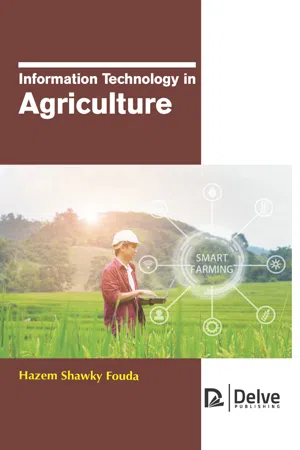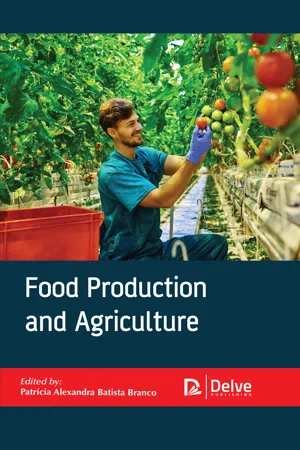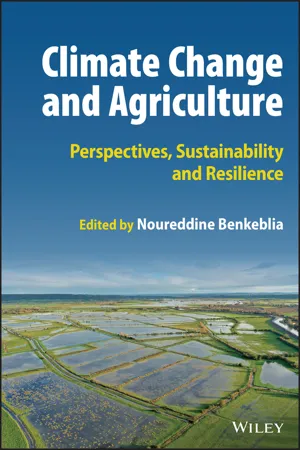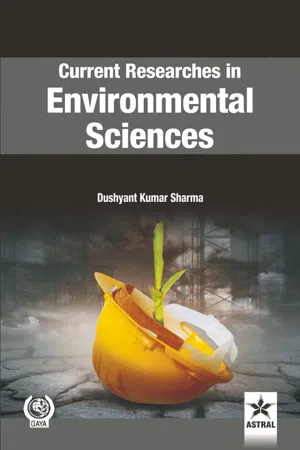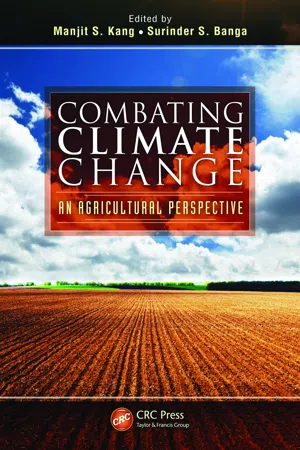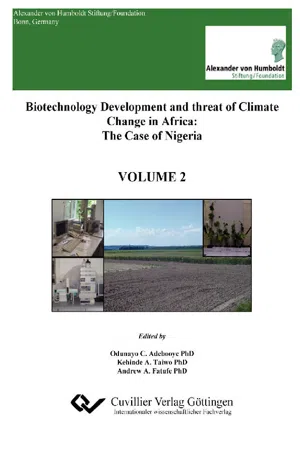Geography
Agriculture and Climate
Agriculture and climate are closely interconnected, as climate factors such as temperature, precipitation, and extreme weather events significantly impact agricultural productivity. Changes in climate patterns can lead to shifts in suitable growing regions, affecting crop yields and food security. Adaptation strategies, such as crop diversification and water management, are crucial for mitigating the effects of climate change on agriculture.
Written by Perlego with AI-assistance
Related key terms
1 of 5
10 Key excerpts on "Agriculture and Climate"
- eBook - PDF
- Hazem Shawky Fouda(Author)
- 2019(Publication Date)
- Delve Publishing(Publisher)
Introduction to Agriculture: A Global Perspective 1 CONTENTS 1.1. Introduction ........................................................................................ 2 1.2. Agriculture as Landscapes of Food Production .................................... 4 1.3. The History of Agriculture ................................................................... 7 1.4. Types of Agriculture .......................................................................... 11 1.5. Agricultural Economics ..................................................................... 16 1.6. Agriculture And Economic Development .......................................... 17 1.7. Implications For Management of Agroecosystems ............................. 20 References ............................................................................................... 23 Information Technology in Agriculture 2 Agriculture is defined as the art and science of cultivating plants as well as livestock. In the growth of secondary human civilization, agriculture played a great role. The chapter initially deals with the concept of agriculture and its role in the supply of food. A brief history of agricultural practices has been discussed. Different kinds of agriculture such as nomadic herding, shifting cultivation, dairy farming, etc. are defined in the middle part of this chapter. At the later part of the chapter, agricultural economics has been explained. At the end of this chapter, implications for management of agroecosystems have been discussed in brief. 1.1. INTRODUCTION Agriculture is known as the human enterprise in which the natural ecosystems are used for the production of food, fuel and fiber. Considering the gradually increasing population, agriculture is an essential process to take place. Devoid of the improved production of edible biomass, simply there would not be sufficient amount of food to eat, as edible biomass characterizes the system of agriculture. - eBook - PDF
- Frank H. Baker(Author)
- 2019(Publication Date)
- CRC Press(Publisher)
Part 4 WATER, WEATHER, AND CLIMATE Wayne L. Decker 20 WORLD AGRICULTURE IN HOSTILE AND BENIGN CLIMATIC SETTINGS CHARACTERIZATIONS OF CLIMATE Health, nutrition, and suffering of the human popula-tion are determined, in part, by weather and climate. Regional wealth and the levels of economic development are impacted by the natural resources, including the climate resource. But agriculture and the associated food produc-tion industries are more directly affected by weather and climate than any other sector of the economy. Climate determines production potential of both grain and livestock producers, identifies strategies available to the producer for resource allocations and marketing, and determines the feasibility of plans for exports and imports of commo-dities. An improved understanding by agriculturalists of the nature of the climatic resource is essential if the impacts of climatic risks are to be minimized. Climate is defined by the space and time distribution of weather events: temperature, precipitation, wind, humidity, and sunshine. In spite of the unpredictability of weather events, climate occurs systematically in both the space and time scale. As a result of these consistencies, climatic zones are easily recognized. For example, in the tropics and subtropics some regions are consistently rain-free in summer, others are smaller areas with an even seasonal distribution and abundant rainfall. In the tem-perate latitudes, the continental regions also demonstrate regional consistencies in climate. The west coasts of continents are mild with abundant winter rainfall, while the continental interiors tend to exhibit summer maximum of precipitation and marked seasonal temperature variations (Mather, 1974). In most climatic regions, there are periods during the year with hostile climates for agriculture. These climatic hostilities are associated with temperature stresses (both high and low) and with deficiencies of rainfall. - eBook - PDF
- Patrícia Alexandra Batista Branco(Author)
- 2019(Publication Date)
- Delve Publishing(Publisher)
THE EFFECT OF ENVIRONMENTAL FACTORS AND CLIMATE CHANGE ON AGRICULTURAL FOOD PRODUCTION CONTENTS 8.1 Introduction ..................................................................................... 174 8.2 Environmental Factors ..................................................................... 174 8.3 Some Climatic Elements And Their Relationship to Farming Systems ........................................................................... 189 Chapter 8 Food Production and Agriculture 174 8.1 INTRODUCTION The logical subtleties in the environmental change domain are plentiful. In the dangerous atmospheric deviation (otherwise known as an environmental change) domain, there is a range of convictions among people in general. The individuals who tend to see these issues in dark or white terms, and who would prefer not to be bothered with understanding the points of interest of the global temperature rise have a tendency to incline toward either extreme. It is clear and evident that global warming is man-made and proper policy formations, as well as regulation, is required to deal with it as the consequences can be life-threatening. 8.2 ENVIRONMENTAL FACTORS Physical elements in any given place determine what a farmer can produce, how and when to produce. Certain ecologic parameters are possibly the most important factor for a farmer. These include: • Rainfall characteristics • Temperatures characteristics • Soils characteristics Of these parameters rainfall pattern, its distribution, reliability, intensity and effectiveness are the most significant factors. It is the main cause of uncertainties that surround the farmer’s decision-making environment. On the other hand, soils, the surface configuration of the land and temperatures are equally useful determinants of the farming activities at the regional level. However, some of these technical elements are difficult to quantify due to the paucity of accurate data. - eBook - PDF
Visualizing Human Geography
At Home in a Diverse World
- Alyson L. Greiner(Author)
- 2017(Publication Date)
- Wiley(Publisher)
(Source: Adapted from Chisholm, 1968.) Livestock ranching Grain farming Forestry Market gardening Central city Navigable river Mixed crop and livestock farming Model with a uniform surface Model altered by navigable river A small city with its own production zones Livestock fattening 1. What accounts for our ability to profitably transport timber over longer distances today? 2. What does the diagram suggest about how terrain might influence land use? 3. What type of space—absolute, relative, or relational—informs this model? Think Critically 256 CHAPTER 9 Agricultural Geographies 3. Explain how agriculture has been affected by globalization. 4. Identify at least two global food issues. 1. Define desertification and salinization. 2. Distinguish between sustainable agriculture and organic agriculture. Agriculture, the Environment, and Globalization LEARNING OBJECTIVES A griculture and the environment are inti- mately interconnected. Soil or climatic con- ditions in an area can influence decisions about what to grow or how to use the land. At the same time, the practice of agriculture can have a significant impact on the environment. Since the first agricultural revolution, clearing forests and draining wetlands have been common strategies for in- creasing the acreage devoted to cropland. Human actions as well as changes in climate can contribute to desertification. Overgrazing damages veg- etation, while poor crop management depletes the soil’s fertility. Both of these practices can create environments that are unable to sustain the herds or crops that they once did. Irrigation can have a detri- mental effect on the environ- ment, even though it is usually thought of as a strategy for ex- panding agriculture. If irrigation draws on groundwater aquifers, water usage has to be monitored so that the aquifer is not depleted. In soils that drain poorly, irrigation can lead to waterlogging and crop death. - eBook - PDF
Climate Change and Agriculture
Perspectives, Sustainability and Resilience
- Noureddine Benkeblia(Author)
- 2022(Publication Date)
- Wiley(Publisher)
1 Climate Change and Agriculture: State of the Art, Challenges, and Perspectives 2 communities that this change will likely impact not only agriculture production, food, and livelihood security but also the international economy and trade as well as human civiliza- tion (Brooks et al. 2009; Cottier and Shariff 2013; Imran et al. 2017). Over the last century, our planet has known a warming by 0.7 °C, and this warming is the result of human activi- ties such as the use of fossil fuels and agriculture including livestock development. On another hand, learning about climate change and committing ourselves to protect our envi- ronment and mitigating this change is also one of the strategies that play a major role in addressing this challenge (Bentz 2020), and this human intervention will be a sin qua non- condition to mitigate these threatening changes. During the COP21 (https://www.un.org/ sustainabledevelopment/blog/category/climate-change/cop21/) and Paris agreement where (i) a global framework was set out in order to avoid climate change by limiting global warming to well below 2 °C with a goal to limit it to 1.5 °C, (ii) a commitment to strengthen countries’ ability to deal with the impacts of climate change and support them in their efforts, and the international community and most countries committed to take initiatives and put measures in place in order to limit greenhouse gas emissions, atmospheric carbon dioxide (CO 2 ) concentration is still increasing (Allen et al. 2018; Canadell et al. 2007; IPCC 2018; Ricke and Caldeira 2014). These increasing atmospheric carbon dioxide levels will be accompanied by temperature and precipitation changes (Figure 1.1) (Baker et al. 2018; Ricke and Caldeira 2014; Wigley et al. 1980), and even in the case emission are restricted, significant climate change is thought to be unavoidable (Ricke and Caldeira 2014). Climate change affected lives across the world in drastic and unpredictable ways (Hardy 2003; Pecl et al. 2017). - eBook - PDF
- R. Knowles, J. Wareing(Authors)
- 2014(Publication Date)
- Made Simple(Publisher)
PART ONE: THE STUDY OF ECONOMIC AND SOCIAL GEOGRAPHY CHAPTER ONE MAN AND ENVIRONMENT Geography is currently going through an exciting period in its development as new problems are identified and new methods of analysis are formulated. It is not easy to say precisely what geography is about because geographers often hold different views of the subject, and these views change from time to time, but this is not surprising since geographers are interested in a very wide range of problems and rapid advances are being made in the subject, as they are in all branches of knowledge. Because geography involves such a wide range of knowledge, the subject has been divided into two major areas of study. The first of these is physical geography, which is concerned with the physical environment of landforms, weather and climate, soils, and plants and animals (see Physical Geography Made Simple). The second is human geography, which is concerned with man's activities over the surface of the earth. In many ways this is a false distinction since the activities of man take place within the physical environment, and the physical environment is considerably affected by these activities, but the divi-sion is a useful one and in this book the physical environment will only be considered in relation to man. Human geography can be studied in two principal ways. First, the earth's surface can be studied part by part. This is the approach of regional geography, which seeks to understand the unique character of an area as produced by the interaction of human activity and the physical environment. Secondly, human activity over the earth's surface can be studied part by part. This is the approach of systematic geography, which isolates particular elements such as agriculture, industry or transport, and seeks to understand their spatial patterns and the processes which have produced them. - eBook - PDF
- Sharma, Dushyant Kumar(Authors)
- 2021(Publication Date)
- Daya Publishing House(Publisher)
As the concentrations of these greenhouse gases increase, it alarms us about the impact of this on our agriculture. The effects of climate change and habitat destruction, and their interaction are likely to be one of the greatest challenges to animal and plant conservation in the 21st century. Global warming is having a significant impact on hundreds of plant and animal species around the world. According to IPCC (2001) the most vulnerable sector of climate change is agriculture. Agricultural output, for which water is a basic input, in tropical and temperate regions is sensitive to changes in climate. Crop productivity would be highly influenced within a season by monsoon and temperature besides the other extreme events. With the ever-changing climate in India, perceptible changes in agricultural output could be witnessed. Our Indian agriculture is totally depends upon climate. A survey indicates that about 14th of India’s crop land is flood-prone. On an This ebook is exclusively for this university only. Cannot be resold/distributed. average, about 10 million hectares of crop land is devastated in each year due to impact of flood (De et al., 2004). Climate may have indirect and possibly lagged influences on harvested areas. For example, shortfalls in rainfall can reduce irrigation water supplies, leading to reduce areas under irrigated crops and potentially increased areas under rain fed crops in the subsequent season (Kumar et al., 2004). In the present paper we focus to discuss the effect of climate change on agricultural products. Effect of Climate Change on Agriculture Changing climate affects each and everyone’s life but the worst affected would be millions of small and marginal farmers who totally depend upon agriculture. Secondly in temperate latitudes a rise in temperature would help countries increase food productivity. - eBook - PDF
Combating Climate Change
An Agricultural Perspective
- Manjit S. Kang, Surinder S. Banga(Authors)
- 2013(Publication Date)
- CRC Press(Publisher)
Around 2006, there were 276 Mha of irrigated cropland (FAO, 2006), which represented a five-fold increase since the beginning of the twentieth century. Agriculture accounts for more than two-thirds of human water use; in Asia, agriculture’s share is 80% (FAO, 2002b). Because of the economic importance of agriculture, attention must be paid to developing a sustainable global agricultural system. In the following section, we summarize broad predictions of future impacts of climate change on agricultural and economic systems and developmental pathways to a sustainable global agricultural Table 2.1 Catastrophic Weather-Related Events between 2005 and 2011 and Their Consequences Extreme, Record-Breaking Event Year Area Financial or Human Loss Category 5 hurricane 2005 United States Hurricane Katrina caused 1836 deaths plus billions of dollars in damage Wettest May–July since 1766 2007 England and Wales Flooding caused US$4.7 billion in damage Hottest summer since 1891 2007 Southern Europe (Greece) Extensive wildfires Heat wave 2009 Victoria, Australia Devastating brush fires; nearly 200 human deaths Highest December rainfall since 1900 2010 Eastern Australia Flooding in Brisbane in early 2011; US$2.6 billion in damage Record rainfall 2010 Pakistan Flooding affected 20 million people; around 3000 human deaths Record tornado activity since 1950 2011 United States (Joplin, Missouri) 116 Human deaths Wettest January–October; Hurricane Irene 2011 Northeastern United States Severe flooding Extreme July heat wave 2011 United States (Texas, Oklahoma) Wildfires burned 1.21 million hectares; ~ US$7 billion in damage Hottest and driest spring since 1880 2011 Western Europe (France) 12% Grain harvest lost 15 GLOBAL Agriculture and Climate CHANGE system armed with improved adaptation and mitigation potential. The issues that follow have been discussed in light of direct or indirect impacts of climate change relative to global agriculture. - eBook - PDF
Biotechnology Development and threat of Climate Change in Africa
The Case of Nigeria - VOLUME 2
- (Author)
- 2010(Publication Date)
- Cuvillier Verlag(Publisher)
As grassroots daily lives are guided by certain belief systems, local knowledge is seen as pivotal to rural livelihoods. Be it in agriculture, forest conservation and traditional medicine, to mention a few, indigenous knowledge forms the basis for local level decision-making of the rural people (See for instance Brokensha et al. 1980; Kolawole 2009, 2005, 2003, 2001; Warren 1990, 1990). Noted for their sensitivity, agricultural practices are engendered and directly influenced by geographical elements like rainfalls, temperature, soils and vegetations. They all interplay to influence the pattern of agricultural practices and productivity in a given locale. Although becoming a global attention in the recent times, climatic change is not a new phenomenon. Hitherto ‘unnoticed’, the constant progression and growth of world’s population combined with modernisation have over the years gradually and surreptitiously impacted on the environment. Indeed, the recent hues and cries about climate change have been informed by the sharp variations now noticed in global weather conditions (See Sachs 2008; IPCC 2007). Unheard, smallholder farmers have had to contend with this variability as the years went by. Through cognitive mapping and validations, smallholder farmers are thus able to discern the weather: they have developed local technologies to predict and adjust to the vagaries of weather. James Shikwati, Director of Inter Region Economic Network based in Kenya buttressed this claim succinctly thus: 77 There was a time in Africa when elders would talk to the drought and negotiate their way into receiving rainfall. With their unique understanding of causation, elders would either sacrifice a black sheep or ask a virgin girl to bathe in a lake in order to draw the attention of the rain gods. Would that they could do so now (Shikwati 2009). Shikwati’s (2009) viewpoint may sound primitive and anachronistic, yet it is just the plain truth. - eBook - PDF
- Singh, Amrit Lal(Authors)
- 2021(Publication Date)
- Daya Publishing House(Publisher)
A detailed analysis for coarse cereals and pulses is necessary to predict the effects of climate change on these crops. Therefore, depending upon the location, varieties with appropriate duration and tolerance to biotic and abiotic stresses will have to be developed. In addition a great effort will have to be made towards water management. 10. Vulnerability of Agriculture to Climatic Changes 10.1. Crop Vulnerability Since agriculture is totally depend upon the nature and natural resources for its successful establishment, any changes in the climatic and its components is directly and indirectly related with crop and animal production through their productivity and quality. As compared to regulated farming system where the crop and animal production take place under controlled management condition (irrigation, fertilization, crop protection etc.), the natural or rainfed agriculture is highly prone to natural calamities such as drought, flood, high temperature, insect and disease infestation etc., because under controlled management conditions the negative impacts of climatic variability could be trade off to a great extent by additional supply of inputs such as irrigation, fertilization, pesticide application and the loss in agricultural production could be minimized substantially. However, rainfed agriculture is severely affected by natural calamities or climatic variability as there are little scope for combating the negative impact of adverse climatic conditions. Similarly, the rich farmers will be least affected than those of poor and marginal farmers to any climatic aberration as the poor farmers have neither financial nor technological support to combat the natural calamities, and if the climate aberration continue for 2-3 consecutive years, then there is no option left except their migration from native place to the new places for This ebook is exclusively for this university only. Cannot be resold/distributed.
Index pages curate the most relevant extracts from our library of academic textbooks. They’ve been created using an in-house natural language model (NLM), each adding context and meaning to key research topics.
